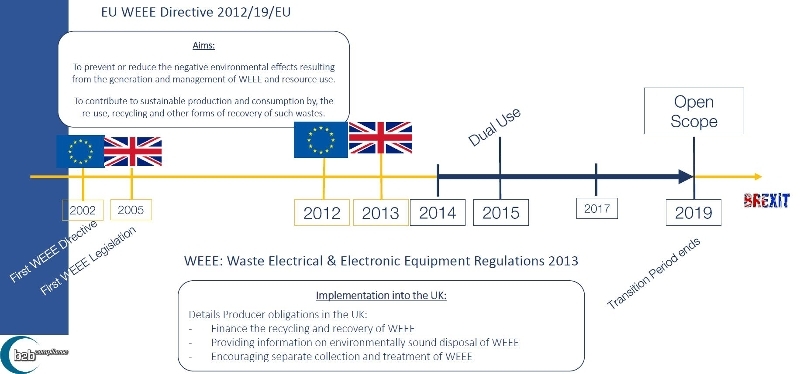
Waste Electrical and Electronic Equipment (WEEE) such as computers, TV-sets, fridges and cell phones is one the fastest growing waste streams in the EU, with some 9 million tonnes generated in 2005, and expected to grow to more than 12 million tonnes by 2020.
Starting from 15 August 2018, the Directive will have an ‘open scope’ and all EEE must then be placed in one of the six new categories set out in Annex III of the WEEE directive:
1. Temperature exchange equipment
2. Screens, monitors, and equipment containing screens having a surface greater than 100 cm 2
3. Lamps
4. Large equipment (any external dimension more than 50 cm)
5. Small equipment (no external dimension more than 50 cm)
6. Small IT and telecommunication equipment (no external dimension more than 50 cm)
DEFRA (Department for Environmental and Food & Rural Affairs) plan to implement ‘open scope’ in the UK from 1st January 2019. EEE will only be out of scope if it falls under one of the exclusions explicitly mentioned in Article 2, paragraphs (3) and (4):
3. This Directive shall not apply to any of the following EEE:
(a) arms, munitions and war material intended for specifically military purposes;
(b) equipment which is specifically designed and installed as part of another type of equipment that is excluded from or does not fall within the scope of this Directive, which can fulfil its function only if it is part of that equipment;
(c) filament bulbs.
4. In addition to the equipment specified in paragraph 3, from 15 August 2018, this Directive shall not apply to the following EEE:
(a) equipment designed to be sent into space;
(b) large-scale stationary industrial tools;
(c) large-scale fixed installations, except any equipment which is not specifically designed and installed as part of those installations;
(d) means of transport for persons or goods, excluding electric two-wheel vehicles which are not type-approved;
(e) non-road mobile machinery made available exclusively for professional use;
(f) equipment specifically designed solely for the purposes of research and development that is only made available on a business-to-business basis;
(g) medical devices and in vitro diagnostic medical devices, where such devices are expected to be infective prior to end of life, and active implantable medical devices.
The simplest and relatively inexpensive way to make sure that you comply with the WEEE directive is to join a WEEE compliance scheme such as B2B compliance. It takes a while to get the processes in place so if you haven’t already joined a scheme, now is the time to start discussions. For more information, please contact Andrew Evans.
